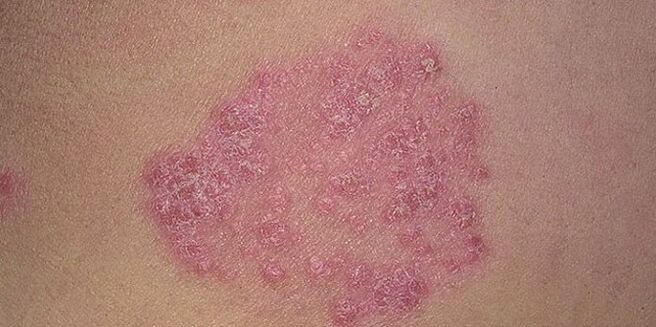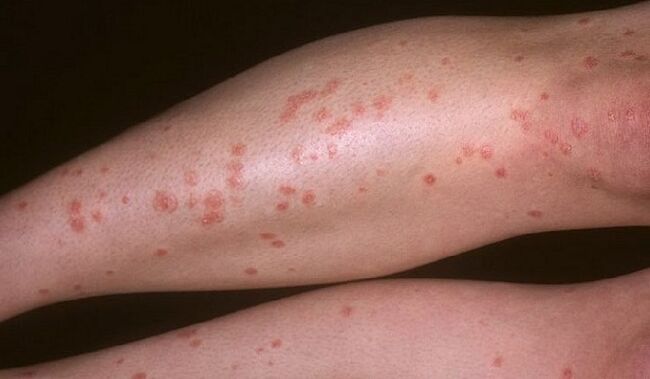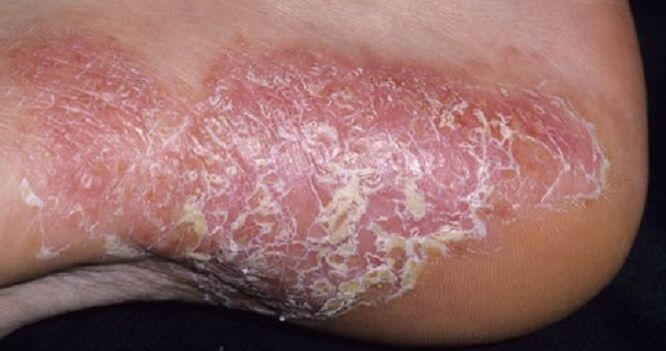Psoriasis of the feet is a skin disorder in which itchy papules, spots or pustules appear on certain parts of the limbs. Over time, they grow and merge into plaques. This disease is incurable and chronic. A well-designed complex therapy helps to quickly alleviate the symptoms of psoriasis on the legs. Therefore, if we want to achieve stable remission (completely or partially cleanse the skin of the elements of the rash), we do not need to prescribe treatment ourselves.
Causes of pathology
Scientists have not yet understood why psoriasis occurs on the feet and other parts of the body. Many researchers have linked psoriatic skin rash to a genetic disorder in epidermal cells and the consequent overactivity of the immune system. This pathological condition occurs as follows:
- As a result of skin dysfunction, keratinocytes (which make up 90% of epidermal cells) do not have time to mature, but at the same time they multiply rapidly, which leads to a change in the structure of certain areas of the skin.
- In response to such a failure, the body’s immunity sends T-lymphocytes (killer cells) and macrophages (eat cells) to destroy immature and pathologically altered keratinocytes.
- As a result of the accumulation of a large number of immune cells and keratinocytes in the upper layers of the epidermis, the skin grows and begins to peel. No drug can help completely normalize the functions of skin regeneration.
The progression of psoriasis on the feet is facilitated by a bacterial infection that can penetrate the skin through small scratches, as well as a disturbed hormonal background, contact allergic dermatitis and a number of other external factors.
How psoriasis looks on the feet, depending on the type of disease
Psoriatic lesions on the feet and knees of the feet can look different from person to person. This factor is explained by the cyclical course of the disease. In addition, one or more forms of psoriasis may develop on the skin of the feet, including palmar-plantar, common (vulgar), tear-shaped, spotty, as well as psoriasis of the nails and joints.
Psoriasis of the legs and feet
Elements of psoriatic rash can be localized on different parts of the skin of the feet:
- on the knees;
- on the lower legs;
- on the heels;
- in the thighs.
Psoriasis on the lower leg, foot, knee joint and inner thigh begins with the appearance of individual red papules and severe itching (typical of spotty and vulgar forms of the disease) or small pink and purple spots (with drop-shaped psoriasis).

In the first case, the elements of the rash protrude slightly above the surface of the skin, differ in density and have a tip with a silvery shell, which peels off when scraped with a fingernail. Over time, the papules enlarge, and those that are close to each other merge into a single plaque. As a result, they completely cover the skin of the knee or cover firm areas of skin from the knee to the feet. Peeling appears on the surface of the plaques.

In the initial stage, the elements of psoriatic rash in the form of drops affect the entire skin of the feet with the same type of small rash. Then, as the disease progresses, the individual spots coalesce into groups and cover large areas of skin on the feet. Such psoriatic lesions rarely occur on the heels.

Palmar-plantar psoriasis often develops on the soles. The elements of the rash appear on the inflamed skin of the feet in the form of small spots and pustules with clear borders and yellow sterile contents. If the pustules on the legs open, then fluid leaks out of them, dries and forms a yellowish crust, the sores beneath it also dry out.
Pustules that do not rupture are covered with dry scales. Gradually increasing and combining into groups, the scaly layer begins to tighten the skin strongly, causing discomfort when walking. The skin around the plaques becomes thick and dry, cracking. Through such cracks, the infection usually penetrates into the deep layers of the dermis, after which crying and skin deterioration begin.
Psoriatic arthritis
In most cases, psoriasis of the feet in the plaque causes psoriatic joint damage. This arthritis is divided into 5 types:
- Symmetrical - simultaneous inflammation of the paired knee joints, hip, ankle or foot region.
- Asymmetric - pathological changes affect large and small joints at the same time, for example, one knee joints and finger joints.
- Inflammation of the distal joints - small joints on the fingers closer to the nails swell.
- Spondylosis - Arthritis affects the lumbosacral spine, resulting in pain in the hips and lower extremities.
- Deforming arthritis is a rare inflammatory pathology in which the small joints of the fingers are completely destroyed.
The skin over the swollen joints swells, becomes purple-blue and becomes hot.
Nail plate damage
Psoriatic nail damage occurs in the background:
- psoriatic arthritis in 80-90% of cases;
- vulgar or pustular psoriasis in 50-60% of cases.
In 5-10% of clinical cases, psoriasis on the legs is primary, ie it occurs on its own, it is not preceded by psoriatic lesions of the joints or skin of the legs.
Initially, common psoriasis of the soles or psoriatic inflammation of the distal joints of the fingers causes pathological changes in the skin of the periungual region. Then the pathology spreads to the root of the nail or affects the nail plate lying on it. There is a deformation of the nail - the creation of depressions, transverse lines - and a change in the color of the plate.
Similar signs of psoriasis in women are rarely seen in youth, most often the disease occurs in young men. In old age, psoriatic nail damage affects both women and men equally.
Stages of progress
Psoriasis of the lower extremities, if left untreated, goes through 3 stages of development:
- initially;
- progressive;
- stationary.
After that, the pathological changes stop, the remission phase begins. Without preventive treatment, the disease continues over time.
The manifestation of the initial stage of the disease on the feet is characterized by the formation of a small single rash, in the form of spots, papules or pustules. It may initially appear on the bends of both knees of the legs at once. The elements of the rash are red or pink, and then their tips are covered with white scales. The initial phase of psoriasis lasts about 3 weeks. During this time, the papules or pustules increase in size and combine into groups.
The initial stage of psoriasis can be stopped if you seek professional help immediately. But more often than not, people ignore the symptoms of the manifestation of the disease, which is why psoriasis continues to develop. In the progressive phase, the number of psoriatic plaques on the skin of the feet increases, those that are close to each other merge into "paraffin lakes" of different shapes and sizes. Psoriasis on the fingers leads to inflammation and desquamation of the periungual tissue and damage to the nails.
The progressive period is characterized by the Kebner phenomenon, when a psoriatic rash forms on the healed skin, for example, after a cut or scratch.
In the stationary phase, psoriasis of the feet and other areas of the skin of the feet continue to manifest as severe itching and peeling. However, new elements of the rash no longer appear and plaques stop growing. There is no inflammatory edge around them; in its place dry scales appear. If treatment is stopped at this stage, the worsening of the disease will start again. Otherwise, psoriatic plaques stop peeling, some of them disappear completely, some just lighten - the remission phase begins.
How to treat psoriasis on the legs
The treatment regimen for psoriasis on the legs is compiled for each patient separately, taking into account the location of the rash, the form of the disease, the stage of progression and a number of other factors. It is dangerous to invent the treatment of this disease on your own because complications can occur in the form of extensive skin lesions, inflammation of the joints, all the way to their destruction and the addition of a bacterial (staphylococcal, streptococcal) infection.
Medications
First, psoriasis foci are affected by non-hormonal fats:
- tar, naphthalene - ointments relieve inflammation, they are antiseptics, but they should be used only according to the doctor's instructions because they have serious contraindications.
- sulfur - salicylic ointment, salicylic acid - refers to keratolytic agents (destroy the stratum corneum). They have an exfoliating effect and help dissolve plaques.
- fats that contain solidol, soften the skin of the feet, have a regenerating effect.
- fats that contain the active form of vitamin D3 slow down the process of cell division, thus reducing inflammation and peeling of the skin on the feet.
If non-hormonal drugs do not help stop foot psoriasis, then corticosteroid ointments are prescribed, which are divided into:
- Weakly active - the agents act on the surface of the skin, suitable for the initial stage of psoriasis. Some fats from this group are approved for use in children, pregnant women and nursing mothers.
- Moderately active - prescribed for the treatment of psoriasis on rough parts of the skin of the feet, especially on the knees and soles.
- Very active - prescribed if moderate-grade fats cannot stop the increase in psoriatic plaques on the skin of the feet.
If no ointment for psoriasis helps, then in the phase of disease progression tablets are prescribed simultaneously with external drugs for:
- suppression of immune cell activity;
- prevention of epidermal cell proliferation;
- they also take retinoids - derivatives of vitamin A, needed for the renewal of epidermal cells.
How to get rid of psoriasis on the feet by home methods
Folk remedies for psoriasis are medicines for external and internal use, but in the treatment they should be used with caution as well as medicines.
Questions like how to cure psoriasis at home are forever unanswered. Some homemade recipes help to eliminate the symptoms of the disease for a long time, but they are not completely resolved.
Fat to aggravate
Ingredients:
- unrefined sunflower oil - 1 liter;
- celandine plant - 50 g;
- elecampane root - 50 g;
- acetylsalicylic acid - 50 tab.
Method of preparation: grind tablets and herbs using a coffee grinder, pour the resulting powder into vegetable oil, mix well. Leave for 30 days in a warm and dark place to infuse. During this period, the mixture should be heated every 3 days in a steam bath, stirring, but should not boil.
How to use: strain the drug, mix the resulting liquid with Vaseline (3: 1), apply 3 times a day on psoriatic plates.
An ointment that relieves symptoms in 10 days
Ingredients:
- birch tar - 150 g;
- pharmaceutical alcohol - 150 mg;
- camphor oil - 75 mg;
- chicken egg yolks - 3 pcs.
How to cook: Beat the egg yolks in an enamel bowl, gradually adding camphor, then tar and alcohol. Store the ointment in a dark place.
How to use: Apply gauze pad on inflamed skin of the feet. After three days, you must wash your feet with warm water with tar soap foam, wipe off moisture and reapply the ointment for 3 days. If the disease does not start, the procedure is repeated, after which the skin is cleansed.
During the period of treatment with homemade fats, it is very important to maintain the body's immunity. For this purpose, 1 tablespoon can be taken orally daily. buckthorn oil.
Diet
Proper nutrition is one of the conditions for effective treatment of psoriasis not only on the legs, but also on other parts of the body. Medical scientists have concluded that the allergic factor contributes to the progression of all forms of psoriasis, so allergenic foods should primarily be excluded from the menu:
- chicken eggs;
- sea food;
- natural honey;
- chocolate, cocoa;
- grapefruit;
- lamb;
- pork;
- chicken meat;
- alcohol.
During this period, it is very important to give up sweet, spicy, salty and smoked foods - they slow down the metabolism in the body. The menu should include dairy products, river fish, cereals, baked apples, vegetable oils, green peas, carrots.

Complete starvation for psoriasis, when a person drinks only one water, is contraindicated.
During the exacerbation of psoriasis on the legs, doctors recommend to arrange a day of fasting once a week, for example, eating only apples, kefir or boiled river fish.
Physiotherapy
The answer to the question of how to treat psoriasis of the leg with physiotherapy is quite extensive. For this purpose, doctors prescribe:
- Ultrasound therapy - ultrasound waves coming out of the device cause compression and stretching of the skin tissue, which is done to renew their cells. Thus it is possible to alleviate inflammation, itching and swelling from the skin of the feet.
- Electrosleep - prescribed for psoriasis of the skin of the feet, if the person cannot cope with the stress caused by the pathology.
- Phototherapy - under the influence of ultraviolet rays strengthens the skin's immunity, reduces growth rate and cell division.
Acupressure helps to improve metabolic processes in the skin of the feet with psoriasis. It is recommended to perform only in the period of remission of the disease, otherwise there is a high probability of infection of inflamed skin.
Hygiene rules
In order not to cause the appearance of new psoriatic deposits on the skin of the feet, in the period of remission it is recommended to use only warm water and baby toilet soap with a moisturizing effect for washing the skin. When the disease progresses, the feet should be washed with warm water and tar soap, which not only cleanses the skin, but also alleviates inflammation. After washing, dry the skin and toenails thoroughly with a soft towel.
Additional recommendations
Treatment for psoriasis on the feet will be long term if the person:
- He is engaged in active sports - his feet are sweating, there is a great load on his feet. After training, it is very important to wash your feet with lukewarm water, dry them well, wear clean socks and wide shoes that will allow the skin to breathe.
- It darkens regularly and for a long time in the sun - excessive sunbathing causes burns and disrupts metabolic processes in the skin. In the phase of progression of psoriasis on the skin of the feet, it is better to refuse excessive sunbathing, and in the period of remission, you should use sunscreen.
Prevention measures and prognosis
Today, psoriatic disease is considered incurable. Therefore, once a lasting reduction in symptoms has been achieved, efforts should be made to maintain this condition in the manner recommended by the physician. There is no place for self-medication here.























